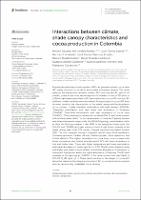| dc.contributor.author | Casanoves, Fernando | |
| dc.contributor.author | Hernández-Nuñez, Héctor Eduardo | |
| dc.contributor.author | Suárez, Juan Carlos | |
| dc.contributor.author | Andrade, Hernán J | |
| dc.contributor.author | Sánchez Acosta, José Ramiro | |
| dc.contributor.author | Duarte Núñez, Ramiro | |
| dc.contributor.author | Gutiérrez, David Ricardo | |
| dc.contributor.author | Gutiérrez, Gustavo Adolfo | |
| dc.contributor.author | Gutiérrez-Montes, Isabel | |
| dc.date.accessioned | 2024-02-28T20:02:16Z | |
| dc.date.available | 2024-02-28T20:02:16Z | |
| dc.date.issued | 2024-02-09 | |
| dc.identifier.uri | https://repositorio.catie.ac.cr/handle/11554/12628 | |
| dc.description.abstract | Properly designed agroforestry systems (AFS) can generate optimal cocoa bean (BC) yields, produce co-products and provide ecosystem services. This study analyzes the interactions between climate, AFS structure and BC yield in six climatic zones across three natural regions of Colombia. A total of 305 plots of
1,000 m2 each were established in 132 farms where the cocoa-AFS structure, BC yield and climatic variables were determined. Five typologies of cocoa-AFS were obtained based on the characteristics of the shade canopy and the abundance of cocoa trees: “Highly diversified multistratum with high biomass” (HDMHB),“Diversified multistratum with high shade and abundance of Musaceae (DMHSM),” “Diversified multistratum with high abundance of cocoa trees (DMHDC),” “Diversified monostratum with low shade (DMLS)” and “monostratum with minimal shade (MMS).” In the departments of Huila and Caquetá, Andean
and Amazonia regions, respectively, the HDMHB typology predominated, while in Meta, the Orinoquia region, it was MMS. In the temperate-humid zone, the DMHDC and DMHSM typologies were not found. A high floristic diversity of the shade canopy was found: 229 species; Caquetá registered the highest number
(152). The most frequent canopy companion species were Musa paradisiaca, Cariniana pyriformis, Cedrela odorata, Psidium guajava, Musa sapientum, and Cordia alliodora. The highest abundance of cocoa trees occurs in areas with lower temperature and relative humidity and in AFS with lower abundance of
fruit and timber trees. Zones with higher temperature and lower precipitation had higher abundance of timber species (r = 0.23). The BC yield is higher in areas with higher precipitation and is related to the lower abundance of individuals of timber and fruit species, and to the higher abundance of Fabaceae. The BC yield depends on the typology (p < 0.0001) of the cacao systems and was higher in DMHDC (1,148 kg ha−1 yr.−1). These results are key for the design of cocoa-AFS farms that maximize the integral production of BC, co-products and ecosystem services, approaching sustainable cocoa farming. | es_ES |
| dc.format.extent | 13 páginas | es_ES |
| dc.language.iso | en | es_ES |
| dc.publisher | Frontiers | es_ES |
| dc.relation.ispartof | Frontiers in Sustainable Food Systems | es_ES |
| dc.relation.uri | https://doi.org/10.3389/fsufs.2024.1295992 | es_ES |
| dc.subject | Sistemas agroforestales||agroforestry systems||sistemas agroflorestais||systèmes agroforestiers | es_ES |
| dc.subject | Sombra||shade||sombra||ombre | es_ES |
| dc.subject | Theobroma cacao||Theobroma cacao||Theobroma cacao||Theobroma cacao | es_ES |
| dc.subject | Producción||production||produção||production | es_ES |
| dc.subject | Servicios de los ecosistemas||ecosystem services||undefined||services écosystémiques | es_ES |
| dc.subject | Composición botánica||botanical composition||composição botânica||composition botanique | es_ES |
| dc.subject | Colombia||Colombia||Colômbia||Colombie | es_ES |
| dc.subject | Cocoa | es_ES |
| dc.subject | Self consumption | es_ES |
| dc.subject.other | Sede Central | es_ES |
| dc.title | Interactions between climate, shade canopy characteristics and cocoa production in Colombia | es_ES |
| dc.type | Artículo | es_ES |
| dc.creator.id | https://orcid.org/ 0000-0001-8765-9382 | es_ES |
| dc.identifier.status | openAccess | es_ES |
| dc.subject.sdg | ODS 12 - Producción y consumo responsables | es_ES |


